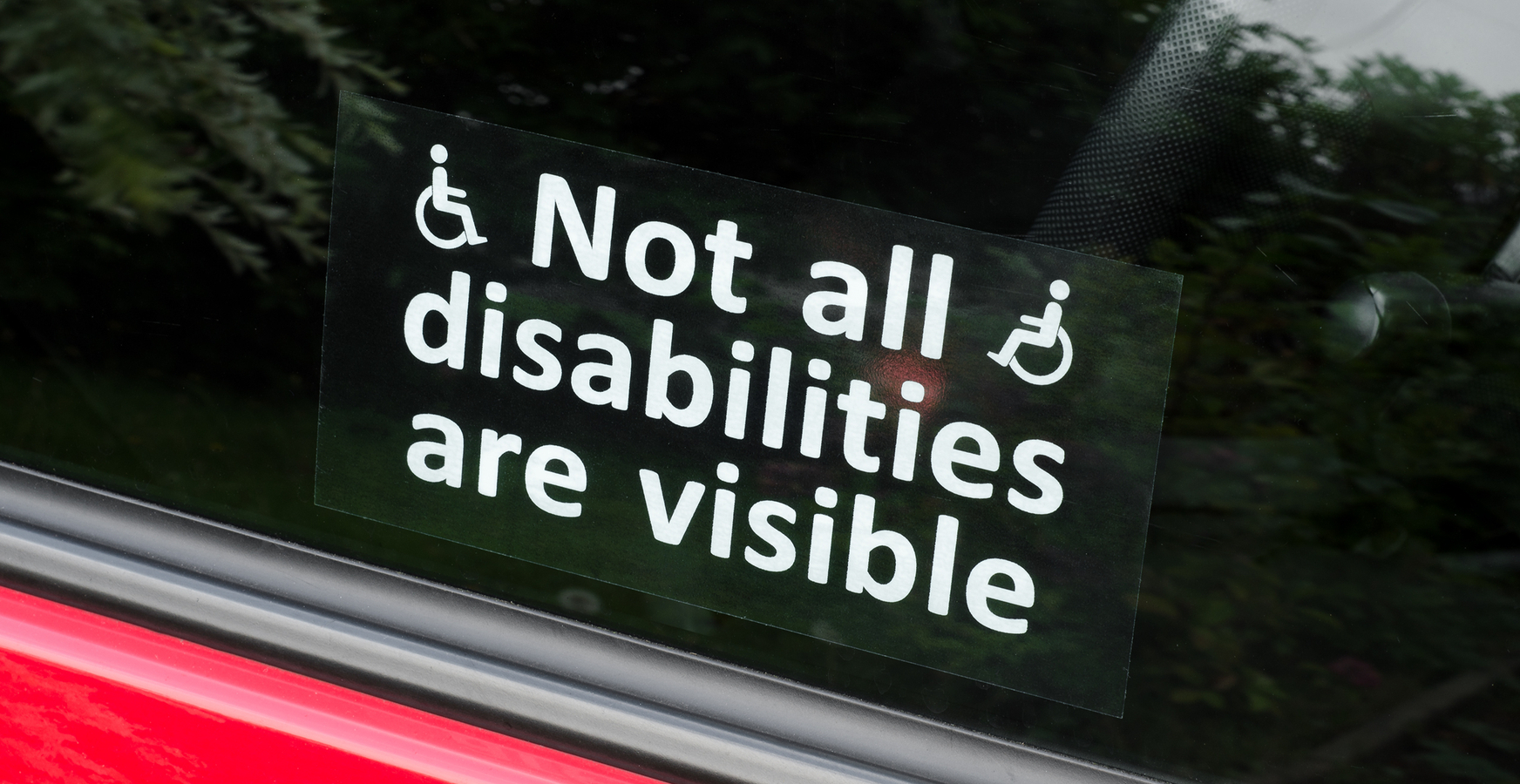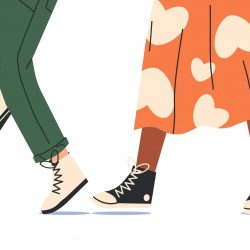I live, work and travel with a persistent pain condition, I have some functional limitations, and I self-identify as ‘disabled’. Accepting I was ‘disabled’ was a difficult, but for me necessary, step in moving on with my life. It has facilitated me being able to access support offered by my employers and by transport services in order to live as full and meaningful a life as possible.
There are a number of ‘definitions’ of the term ‘disabled’, but in England, Scotland and Wales you’re disabled under the Equality Act 2010 if you have a physical or mental impairment that has a ‘substantial’ and ‘long-term’ negative effect on your ability to do normal daily activities. Substantial is defined as meaning more than minor or trivial and long term means 12 months or more. There are special rules about recurring or fluctuating conditions, and there are special rules about some progressive conditions. Further information about what all this actually means in practice can be found *HERE*. Examples of activities that might meet the criteria, for people suffering with physical impairments, are given at the end of this blog (taken from the Equality Act Guidance).
Looking back on my persistent pain journey, following my manual handling accident in July 2008, it is obvious to me now that once my difficulties had been present for a year that I met the Disability Discrimination Act definition of disability (now the Equality Act). However, I don’t remember at that time ever thinking of myself as ‘disabled’. As far as I was concerned I was ill, in substantial pain, unable to do various everyday things, and really struggling.
I was fortunate that a year or so after my accident my rheumatology care was transferred to a particularly compassionate and caring rheumatologist, who I remember as being fairly straight with me in terms of what my likely outcomes were. I’m not sure I can remember her using the term ‘disabled’ or ‘disabling’ directly with me, but in February 2012, she wrote a letter to a fellow consultant and put as a diagnosis, ‘Post surgical disabling right sided sciatica following surgery in December 2009.’ Even though I knew I was in difficulty, and the difficulties were likely to be life-long, seeing the word ‘disabling’ as part of a diagnosis had a huge emotional impact on me.
Some might say that using the term ‘disabling’ was unnecessary, and it could be expected that it might have an emotional impact on me, but I would say writing that was probably one of the best things anyone has done for me. I am sure I was still really struggling with acceptance at that time, and however hard the emotions were that resulted from reading that diagnosis, they were emotions I needed to go through. I needed to start to identify as being ‘disabled’, start to access the benefits associated with this, and also be mindful of the associated difficulties.
That letter in 2012 was the start of my emotional journey of self-identification as being disabled.
Some time after receiving the letter from my rheumatologist, I spent time learning about the Disability Discrimination Act, and then the Equalities Act which followed it, and considering whether I really met the criteria for disability or not. For me it was important that I didn’t self-identify as ‘disabled’ incorrectly. (I’m assuming that my rheumatologist’s use of the word ‘disabling’ did not imply that she consciously thought I would meet the Disability Discrimination Act criteria, but that it was being used as a medical term.)
Along this journey of self-identification and further acceptance, I also had to start to outwardly describe myself as ‘disabled’ to others. I found this quite difficult at first. For me it would probably have helped if more of the various clinicians involved in my care, and other people in my life, had used the term ‘disability’ in general conversation more often with me, but I accept this might not be the case for everyone.
Although there are obvious downsides of being ‘disabled’ in terms of daily pain, difficulty in doing things you could once do, the side effects of medication, etc etc, there are a range of ‘benefits’ which can help support you.
There are financial benefits for some people in terms of Personal Independence Payment (PIP) and Employment Support Allowance (ESA). (Even if you meet the Equalities Act definition of disability, this does not mean that you will score enough points in the extensive and detailed criteria set out in the PIP or ESA award – I woudn’t.) There are Blue Badges available for those that meet the Blue Badge criteria, and a range of financial ‘concessions’ at theme parks etc for those that meet their criteria. Some will qualify for a Disabled Persons Railcard, and some for a local authority bus pass. I’m sure there are many other examples.
I have benefitted from support from my employers. I am given assistance in terms of travelling (eg using a taxi when needed), and I have reasonable adjustments in place (as far as possible taken the travelling nature of my work) in terms of suitable chairs/cushions, which meeting rooms I might be allocated to, and which venues I attend. It took me a while to be fully open with my employers about having a disability, mainly I think due to a fairly irrational fear of discrimination, but I don’t worry now. I have had excellent support from my employers and colleagues.
Every person is different, and even those with the same diagnosis are likely to have very different needs, both functionally and in terms of support for their acceptance of their condition and their self-identification, or otherwise, as a disabled person. It certainly helped me when my rheumatologist, and other clinicians, acknowledged that I had entered the world of disability, however hard it was hearing it for the first time!
Tina
Examples of activities that might meet the Equality Act 2010 criteria for disability (taken from Equality Act 2010 Guidance)
Whether a person satisfies the definition of a disabled person for the purposes of the Equality Act 2010 will depend upon the full circumstances of the case. That is, whether the substantial adverse effect of the impairment on normal day- to-day activities is long term. The following are some examples of substantial adverse effects on impairment, taken from the Equality Act 2010 guidance. These are the ones relating to physical difficulties.
- Difficulty in getting dressed, for example, because of physical restrictions, a lack of understanding of the concept, or low motivation;
- Difficulty carrying out activities associated with toileting, or caused by frequent minor incontinence;
- Difficulty preparing a meal, for example, because of restricted ability to do things like open cans or packages, or because of an inability to understand and follow a simple recipe;
- Difficulty eating; for example, because of an inability to co-ordinate the use of a knife and fork, a need for assistance, or the effect of an eating disorder;
- Difficulty going out of doors unaccompanied, for example, because the person has a phobia, a physical restriction, or a learning disability;
- Difficulty waiting or queuing, for example, because of a lack of understanding of the concept, or because of pain or fatigue when standing for prolonged periods;
- Difficulty using transport; for example, because of physical restrictions, pain or fatigue, a frequent need for a lavatory or as a result of a mental impairment or learning disability;
- Difficulty in going up or down steps, stairs or gradients; for example, because movements are painful, fatiguing or restricted in some way;
- A total inability to walk, or an ability to walk only a short distance without difficulty; for example because of physical restrictions, pain or fatigue;
- Persistent difficulty crossing a road safely, for example, because of physical restrictions or a failure to understand and manage the risk;
- Difficulty accessing and moving around buildings; for example because of inability to open doors, grip handrails on steps or gradients, or an inability to follow directions;
- Difficulty operating a computer, for example, because of physical restrictions in using a keyboard, a visual impairment or a learning disability;
- Difficulty picking up and carrying objects of moderate weight, such as a bag of shopping or a small piece of luggage, with one hand;
- Intermittent loss of consciousness;
Tina
@livingwellpain
www.livingwellpain.net




